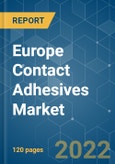Europe contact adhesives market is expected to grow at a CAGR of around 3% during the forecast period. The demand for contact adhesives is widely driven by the recovery in construction activities and increased application in automotive industry for producing lightweight vehicles. However, stringent VOC emission regulations may affect the growth of the studied market.
Key Highlights
- The neoprene-based segment dominated the market. It is likely to grow during the forecast period, owing to the rising demand from construction and footwear industries.
- The shifting focus toward water-borne adhesives is likely to offer opportunities for the contact adhesives market in the region.
- Germany stands to be the largest market for contact adhesives in the region, with consumption being majorly driven by the growing demand from end-user industries, such as packaging, construction, woodworking and footwear.
Key Market Trends
Building and Construction Industry to Drive the Market Demand
- Contact adhesives’ properties such as good cohesion, adhesion and elasticity, high cohesive strength, flexibility, high elastic modulus of substrate, resistance from thermal expansion, environmental resistance from UV light, corrosion, salt water, rain, and other weathering conditions, makes it extensively useful for application in construction industry.
- They are mainly used in wooden flooring and artificial turf, owing to their property of strain crystallization.
- In Europe, countries such as Germany, United Kingdom, Italy, Spain and Russia have been witnessing growth in construction sector, and while this trend is likely to persist over the next two years, the consumption of contact adhesives from construction industry is likely to increase further.
- Germany has the largest construction industry in Europe. The country has been witnessing notable growth in residential construction, which is expected to create demand for contact adhesives in the domestic market.
- Hence, all such trends in the construction sector are likely to drive the consumption of contact adhesives in the region during the forecast period.
Germany to Dominate the Market
- Germany dominate the consumption of contact adhesives in the region, owing to the presence of one of the largest production base of industries, such as aerospace automotive, packaging, and woodworking in the region.
- Construction sector growth in the country is supported by lower interest rates, increase in real disposable incomes, and numerous investments by the EU and German governments.
- Besides, the country has numerous construction projects, such as construction of a new multipurpose sports arena in Munich, on the former site of Olympic cycling track stadium in Munich Olympic Park, along with three additional canopied ice rinks which are planned to be built next to the sports arena for training and recreational use, which can support local sports infrastructure for amateur clubs, schools, and young talents.
- The retail sector in the country is expected to record notable growth due to continuously increasing online grocery orders in the country. Moreover, Germany has introduced a new Packaging Act, which is driving the industry toward eco-friendly packaging practices.
- Hence, all such market trends are projected to drive the consumption of contact adhesives in the country over the forecast period.
Competitive Landscape
Europe contact adhesives market is fragmented in nature. Some of the key players in the market includes 3M, Arkema Group, H.B. Fuller, Sika AG, and Henkel AG & Co. KGaA, amongst others.
Additional Benefits:
- The market estimate (ME) sheet in Excel format
- 3 months of analyst support
This product will be delivered within 2 business days.








